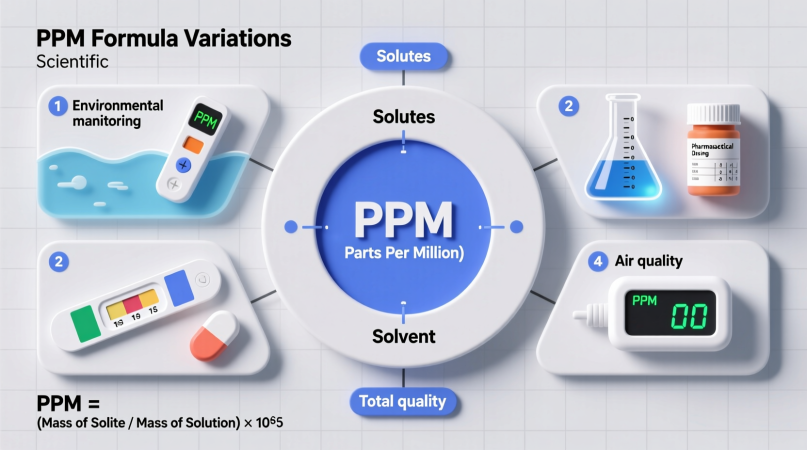
PPM Formula Variations and When to Use Each
If you’ve ever measured the concentration of a substance, you’ve probably encountered the term PPM, or parts per million. But did you know that the formula for calculating PPM can change depending on whether you’re testing water, air, or solids?
Understanding which PPM formula to use is essential for anyone working in labs, environmental monitoring, water quality, or industrial processes.
Why Do PPM Formulas Vary?
PPM is a dimensionless unit that expresses how many parts of a substance are present in one million parts of a mixture. While the goal is always the same—quantifying trace concentrations—the method of measurement and calculation changes with the phase (liquid, gas, or solid) and context.
When Do You Need Different PPM Formulas?
- Water solutions: Most common in drinking water, environmental testing, and industry.
- Air or gases: Used for pollution monitoring, workplace safety, and HVAC.
- Solids (like soil or food): Relevant for agriculture, food safety, and geology.
Let’s break down each scenario.
PPM Formulas for Different Sample Types
1. PPM in Liquids (Aqueous Solutions)
Standard Formula (for Water and Dilute Solutions)
PPM = (mg of solute) / (L of solution)
- When to use: Most water quality tests, pool/spa chemistry, hydroponics, and lab solutions.
- Why: Water’s density is close to 1 kg/L, so 1 mg/L ≈ 1 ppm.
Example:
You have 10 mg of nitrate in 2 liters of water:
PPM = 10 mg / 2 L = 5 ppm
Learn more about water testing at PPM for Water Testing.
Advanced Formula (for Non-Water or Concentrated Solutions)
If the solution’s density differs substantially from water, adjust for density:
PPM = (mg of solute) / (kg of solution)
- When to use: Dense or concentrated solutions, or non-water liquids (e.g., oil, acids).
- Tip: 1 L of solution × density (kg/L) = mass of solution in kg.
2. PPM in Gases
Volume-Based Formula
PPM (v/v) = (Volume of gas) / (Total volume of mixture) × 1,000,000
- When to use: Air quality monitoring (e.g., CO, NO₂, ozone levels), industrial hygiene, and HVAC.
- Units: mL/m³, L/L, or any consistent volume units.
Example:
If you have 2 mL of CO in 1 m³ of air:
PPM = (2 / 1,000,000) × 1,000,000 = 2 ppm
Mole Fraction Formula
For more scientific accuracy, especially under varying temperature and pressure:
PPM = (Moles of gas) / (Total moles of gas mixture) × 1,000,000
- When to use: Research settings, gas mixtures, and calibration gases.
3. PPM in Solids
Mass-Based Formula
PPM = (mg of substance) / (kg of solid sample)
- When to use: Soil analysis, food testing, metallurgy, and geology.
- Why: 1 kg = 1,000,000 mg, so this formula is direct and convenient.
Example:
5 mg of lead in 1 kg of soil = 5 ppm lead.
When Should You Use Each Formula?
Water and Dilute Solutions (mg/L)
- Best for: Drinking water, environmental water, pools, aquariums.
- Why: Simple, linear relationship with PPM for low concentrations.
Gases (Volume or Mole Fraction)
- Best for: Air quality, workplace safety, gas blending.
- Why: Volume and mole fraction reflect how gases mix, especially under changing pressure.
Solids (mg/kg)
- Best for: Soil, food, minerals.
- Why: Mass-based calculations are easiest and most accurate for solid matrices.
For more conversion options, see PPM Conversion Table.
Practical Tips and Common Mistakes
Double-Check Your Units
Always ensure consistency:
- Use mg and L for liquids.
- Use mL or L for gases (volume), or moles for scientific accuracy.
- Use mg and kg for solids.
Adjust for Density if Needed
If your solution isn’t mostly water, multiply volume by density to get mass.
For more on this, see PPM Calculation Mistakes.
Use Calculators for Complex Cases
Online tools like the PPM Solution Calculator and MG/L to PPM Calculator make calculations faster and more reliable.
Special Cases
PPM to Molarity
If you need to convert PPM to molarity in chemistry labs:
Molarity (mol/L) = (PPM × 10⁻³) / Molar Mass (g/mol)
Try the Molarity Calculator for easy conversions.
PPM in Non-Aqueous Solutions
Adjust for solution density and solute characteristics. Always check if the standard water-based formula applies.
Frequently Asked Questions
Is 1 mg/L always equal to 1 ppm?
For water and dilute solutions, yes. For other liquids or concentrated solutions, check density.
Can I use the same PPM formula for air and water?
No, use volume-based or mole fraction formulas for gases; use mass/volume for liquids.
Where can I find more calculators?
Browse the full calculator suite for all PPM formula needs.
Conclusion
Understanding PPM formula variations and when to use each is crucial for accurate measurements in science, industry, and daily life. By applying the right formula for your sample—whether it’s water, air, or soil—you’ll ensure trustworthy results every time. For more expert guidance and easy-to-use calculators, visit ppmcalculator.

Dr. Robert is an industrial chemist specializing in process control, water purification, and quantitative chemical analysis. She has worked with environmental labs and manufacturing facilities to optimize solutions in parts-per-million (PPM) precision and safety compliance.
At PPMCalculator.com, Dr. Robert ensures the accuracy of each calculator and guide through peer review and data validation. Her mission is to make chemistry tools more reliable for engineers, researchers, and students worldwide.
Follow her professional updates on LinkedIn or contact via info@ppmcalculator.com. For More details, Click here
